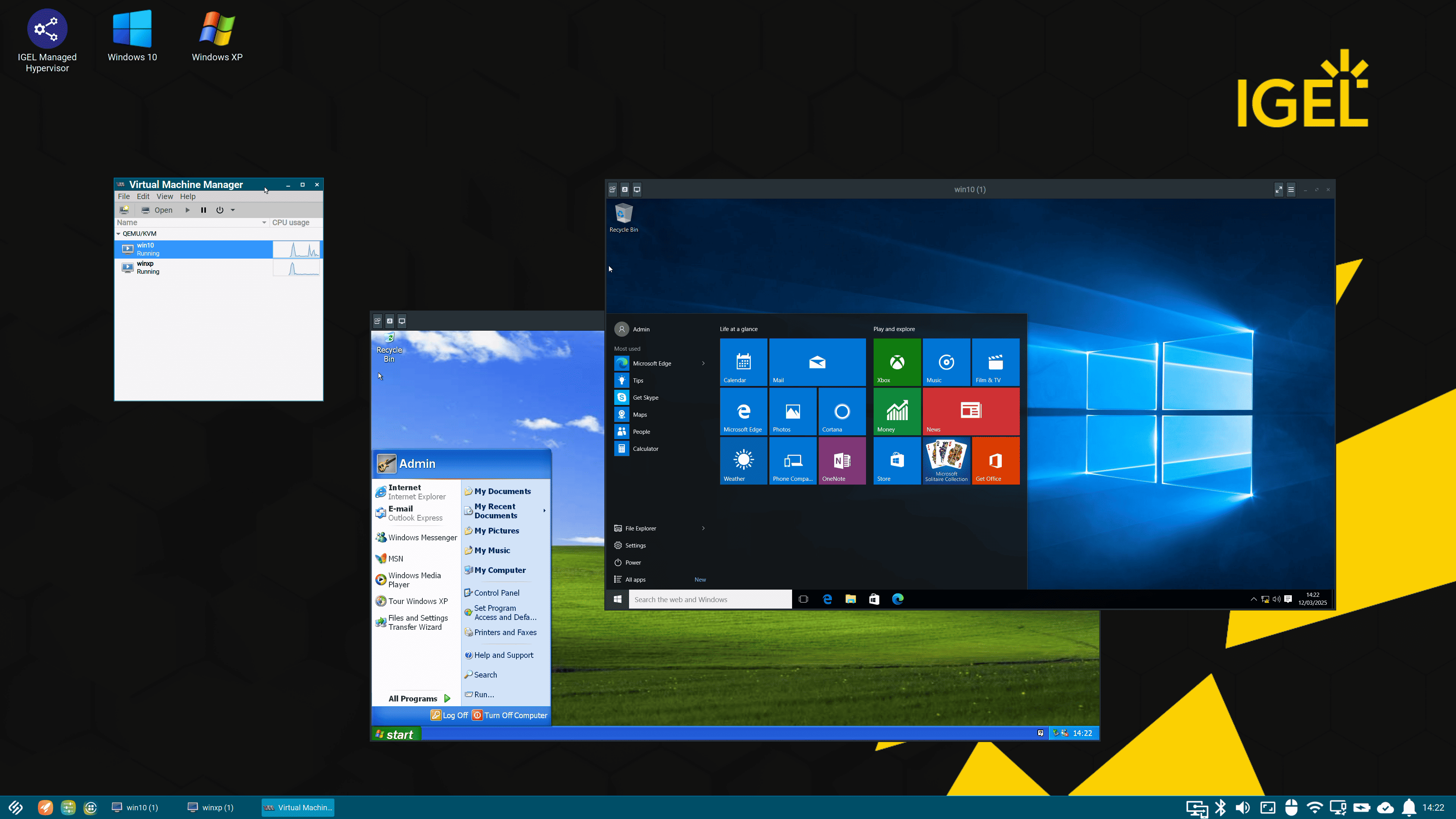The post How to deploy a VM with IGEL Managed Hypervisor in four simple steps appeared first on IGEL.
]]>If you are interested as to why we are releasing a Hypervisor, I recommend you read this Blog post: https://www.igel.com/blog/igel-managed-hypervisor-secure-your-legacy-workloads/
Let’s get started!
What you will need
- IGEL Universal Management Server (UMS) v 12.07.100 or later
- IGEL OS12.6.1 or later
- IGEL Managed Hypervisor App (releasing in Q2 2025)
- WebDAV server to store and deploy the disk images (I used IIS on my UMS server for this in a LAB environment)
The process is very simple; create a VM on an OS12.6.1 or later endpoint, capture the disk image, create a profile in UMS to deploy the disk image to a target OS12.6.1 or later endpoint, then you can remotely manage OS12 and the VM from UMS.

Create
The first step is to create your own ‘Golden Image’. Open the Virtual Machine Manager, click File, New Virtual Machine.

This starts with a wizard which will take you through the steps to create the virtual machine. From selecting the operating system, the storage, CPU and memory to the attached peripherals. In my case I used
a USB storage device with Windows10 and Windows XP ISO files.
Install your selected OS and configure as required.
Capture
Now you have your ‘Golden Image’ we can capture the image and get it ready for deployment. Part of the IGEL Managed Hypervisor app is an export utility called IMH Exporter. To export the VM image to the WebDAV server simply open the IMH Exporter, enter the URL to the WebDAV server and select the VM name you want to export.
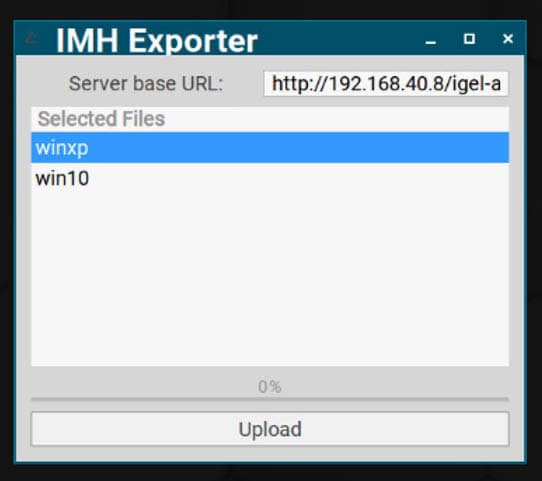
The IMH Exporter will then create two files on the WebDAV server: %vm_name%.img and %vm_name%.xml. The .img file is the disk image (this will be a large file, you will need to consider the storage size and network when exporting) the .xml file is a configuration file detailing all the component the VM needs, such as network, memory, CPU etc.
Deploy
Now we have the Image and the config file we can create a UMS Profile to deploy the Image to a target device (Tip: make sure you don’t send the VM to the device you used to create it on as you will get inconsistent results, if you need to use the same device remove the golden image first)
There are two sections in the IMH App Profile, IGEL Hypervisor Domains and IGEL Hypervisor viewer sessions.
IGEL Hypervisor Domains is used for image deployment. (a domain in this case is the name of the VM). Fill out the details for your VM and the URL to the XML file on the WebDAV server.
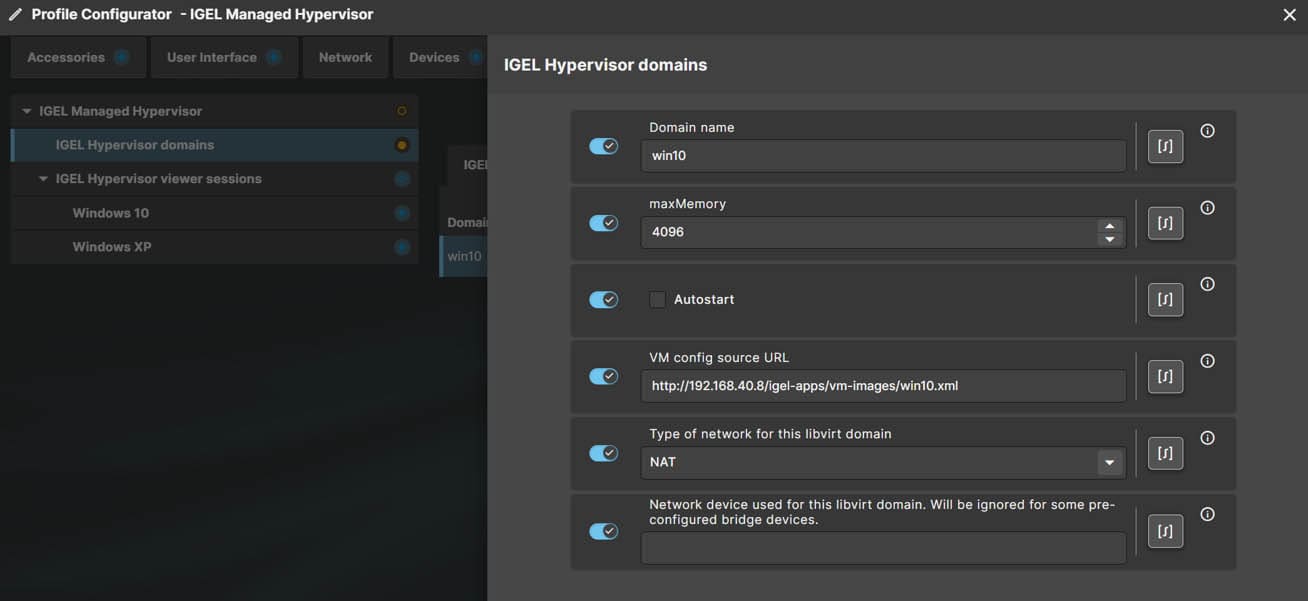
IGEL Hypervisor viewer sessions are used to create an icon which will start a VM viewer on IGEL OS allowing you to see the VM screen, select if you want the VM to auto-start, where the icon will be displayed and if you want the VM to run in kiosk mode.
Apply the profile settings and assign it to a target device.
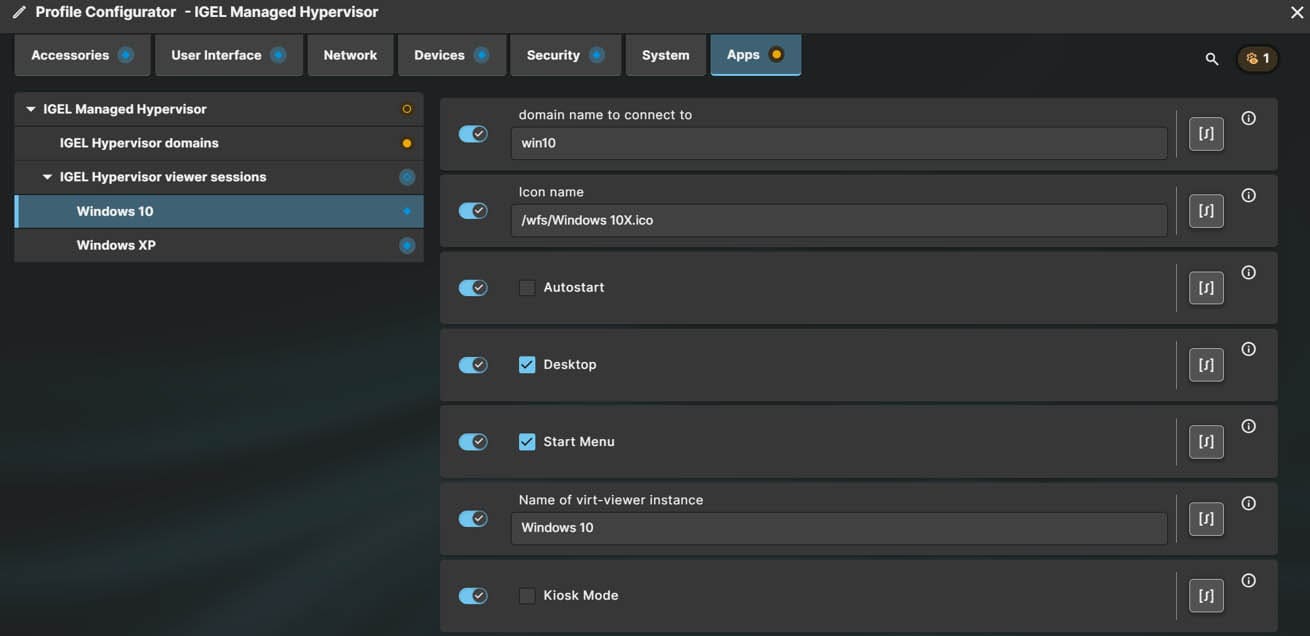
Manage
If all has gone well, you will now have a VM successfully deployed and running. To manage the VM navigate to the OS12 device in UMS, there will be a new TAB called Managed Hypervisor, click this and you will see the VM’s installed on the device and their status. From here you can perform various management tasks, such as, Start, Stop, Delete and re-image.
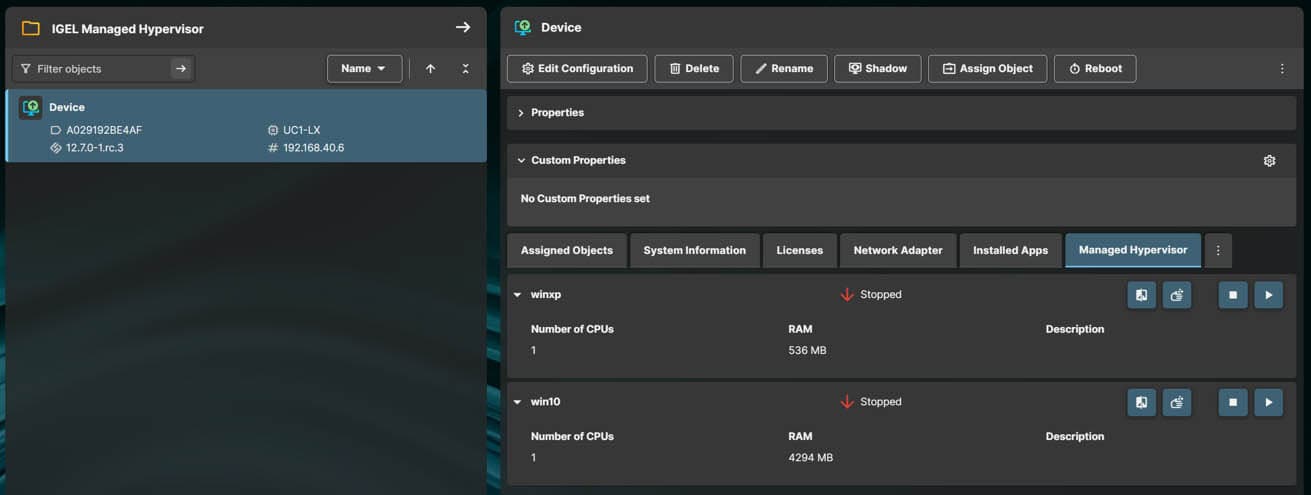
There we have it, four simple steps to getting your first IGEL Managed Hypervisor VM up and running.
If you would like to learn more about the IGEL Managed Hypervisor I will be running Webinars on Wednesday 14th May 2025 diving further into the details, discussing where IMH fits and running through setting everything up.
Registration links below:
10:00am BST | 10:00am ET | 16:00pm AEST
The post How to deploy a VM with IGEL Managed Hypervisor in four simple steps appeared first on IGEL.
]]>The post A New Era for OT Security and Endpoint Management as IT and OT Converge appeared first on IGEL.
]]>As alarming as this statistic is, it is not surprising as the fact remains that many industries run critical systems on outdated, unsupported versions of Windows XP or Windows 7 on legacy devices.
Join the upcoming webinar to learn how to secure legacy systems and achieve modern efficiency to protect OT systems from ransomware and IT outages with IGEL Managed Hypervisor. During the session, IGEL experts will show you how you can achieve:
Prevent exploitation of OS vulnerabilities
Isolate legacy operating systems in a secure, virtualized environment, preventing unauthorized access and exploitation of OS vulnerabilities
Reduce attack surface on the endpoint
Integrate network segmentation, firewalls, and zero trust architectures to reduce attack surfaces and enforce strict access controls, offering advanced protection against ransomware, malware, and data breaches.
Enhance operational resilience
Centrally manage multiple virtual machines with a secure endpoint virtualization platform designed for preventative security with remote troubleshooting, secure updates, and high availability.
IGEL is tackling the challenges of IT/OT convergence head-on with its latest innovation: IGEL Managed Hypervisor, a virtualization platform designed for preventative security to bridge the gap between legacy operational technology (OT) systems and the security demands of modern hardware, enterprise networks, and the cloud. Announced at the IGEL Now & Next event in Miami in March, the IGEL Managed Hypervisor will be available in IGEL App Portal in May 2025.
Join us on Thursday, May 14, 2025. During this session, you will learn about the advantages of the IGEL Managed Hypervisor and how it positions IGEL as a leader in the emerging convergence of IT and OT security.
Two separate webinars will be held. For the EMEA webinar, register here, and for North America, register here.
Read the Blog Securing Biomedical Devices in Healthcare with IGEL Managed Hypervisor
The post A New Era for OT Security and Endpoint Management as IT and OT Converge appeared first on IGEL.
]]>The post Securing Biomedical Devices in Healthcare with IGEL Managed Hypervisor appeared first on IGEL.
]]>Healthcare organizations face an escalating cybersecurity risk as biomedical teams continue running critical medical devices on older versions of Windows. These legacy systems, often essential for imaging machines, meds dispensing, and diagnostic tools, remain unpatched and vulnerable due to vendor restrictions, operational dependencies, or the excessive costs associated with replacing medical hardware. Not only does this create a security issue, but it also creates an operational issue in finding hardware for these critical controllers to run on as new hardware – think TPM2 chips – does not support the outdated version of Windows.
According to a Help Net Security report, 70 percent of medical devices in hospitals run outdated operating systems, making them prime targets for cyberattacks. Meanwhile, research from Claroty’s Team82 found that 63 percent of known vulnerabilities tracked by CISA exist within healthcare networks, due to aging infrastructure and the inability to update Windows-based systems.
The need for a secure, efficient, and cost-effective way to continue operating these devices, using new endpoint hardware, without exposing hospitals to cybersecurity threats is more urgent than ever. This is where IGEL Managed Hypervisor comes in.
How IGEL Managed Hypervisor Strengthens Security for Biomedical Devices
Isolating Vulnerable Windows Instances
IGEL Managed Hypervisor allows biomedical teams to run legacy Windows-based applications securely within a controlled virtualized environment. Instead of running outdated Windows versions directly on endpoint hardware, the IGEL OS acts as a separation layer between the hardware and the Windows instance running inside a managed hypervisor. This approach eliminates persistent malware risk by ensuring a fresh Windows session at every reboot, and provides a read-only, tamper-proof operating environment.
Extending Medical Device Lifecycles with IGEL Managed Hypervisor
Many medical devices rely on outdated versions of Windows, which are incompatible with modern hardware. This forces healthcare organizations to source and maintain aging systems—an expensive and unsustainable approach. IGEL Managed Hypervisor solves this by decoupling software from hardware, enabling legacy Windows-based medical applications to run securely on modern devices. This eliminates the need for outdated equipment, reduces maintenance costs, and enhances security, allowing hospitals to extend the lifecycle of critical medical devices without compromise.
Meeting Compliance and Zero Trust Security Requirements
Regulatory bodies like HIPAA, FDA, and NIST emphasize cybersecurity in medical technology, yet legacy Windows systems often lack built-in Zero Trust protections. IGEL Managed Hypervisor, built on the Preventative Security Model, provides a secure-by-design endpoint foundation that integrates with leading Zero Trust Architecture (ZTA) solutions. It adds an additional firewalling layer to prevent malicious activity and works alongside network segmentation tools to contain threats. By enabling IT to create an immutable, rollback-ready Windows environment, IGEL ensures medical systems can be restarted in a known-good state—much like a non-persistent VDI desktop—supporting the uptime and availability critical for patient care.
Seamless Integration with Existing IT Infrastructure
Healthcare IT teams are stretched thin, managing both modern and legacy environments. IGEL Managed Hypervisor is managed from the IGEL UMS simplifying endpoint management by allowing centralized policy enforcement across all devices, enabling remote updates and patches without disrupting workflows, and supporting Browsers, SaaS, DaaS and VDI integrations
Why IGEL is the Right Fit for Healthcare Biomedical Teams
Hospitals need a pragmatic security approach that works within existing constraints. IGEL Managed Hypervisor offers a security-first design that minimizes attack surfaces by isolating legacy Windows environments, removes the issue of maintaining old hardware, reduces hardware refresh cycles and extends device lifespans, and works across distributed healthcare environments with zero-trust-ready architecture.
In a time where cyber threats to medical infrastructure are escalating, IGEL provides a proven, scalable, and secure way to modernize healthcare IT without disruption.
Want to Learn More?
If your biomedical team is managing legacy Windows devices, IGEL Managed Hypervisor can help secure your infrastructure without sacrificing operational efficiency. Contact us today to discuss how we can help your healthcare organization stay protected.
Learn more about IGEL Managed Hypervisor
View the Demo Video
The post Securing Biomedical Devices in Healthcare with IGEL Managed Hypervisor appeared first on IGEL.
]]>The post Enhancing Zero Trust Authentication with IGEL and 90Meter for Federal and Enterprise Security appeared first on IGEL.
]]>Security and compliance are critical for federal agencies and enterprises operating in highly regulated environments. As cyber threats evolve, organizations must adopt Zero Trust authentication strategies to safeguard sensitive data and prevent unauthorized access.
IGEL, a leader in endpoint security and management, has expanded its partnership with 90Meter, a leading USA-based smartcard software vendor, to enhance support for Zero Trust authentication and endpoint security within IGEL OS 12. This collaboration extends native support for the 90Meter PKCS#11 smart card library to now include NIPRNet, while also updating existing SIPRNet PKCS#11 support. By integrating 90Meter’s PKCS#11 smartcard library, this collaboration delivers seamless and secure identity verification for Virtual Desktop Infrastructure (VDI) deployments and browser-based access.
The IGEL + 90Meter Solution: A Zero Trust Approach
The IGEL and 90Meter integration enables strong identity and credential access management (ICAM) by offering:
- Seamless Smartcard Authentication – Secure authentication for virtual desktops and applications using 90Meter’s PKCS#11 smartcard library.
- Zero Trust Endpoint Security – IGEL OS 12 operates under a Preventative Security Model (PSM), ensuring only verified and policy-controlled devices gain access.
- Regulatory Compliance – Meets DoD, NIST, and FIPS security standards for federal agencies and enterprises.
- Cross-Platform Compatibility – Supports Citrix, Omnissa Horizon, and Azure Virtual Desktop (AVD) for multi-cloud and hybrid environments.
- Browser-Based Access – Enables secure authentication via Microsoft Edge, Chromium, and Firefox, ensuring flexible and user-friendly access.
Preventative Security Model: Fortifying Endpoints
IGEL OS 12 is designed with a Preventative Security Model (PSM) that enforces strict security controls, reducing the risk of cyber threats. Key security features include:
- Read-Only OS – Prevents malware installation and unauthorized modifications.
- No Local Data Storage – Ensures authentication credentials and sensitive information remain protected.
- Trusted Boot & Chain of Trust – Validates OS integrity at startup to prevent unauthorized changes.
- Centralized Security Management – IGEL’s Universal Management Suite (UMS) enforces security policies for controlled access to 90Meter-enabled VDI environments.
Key Benefits for Federal and Enterprise Environments
- Enhanced Security & Compliance
- Prevents unauthorized access with Zero Trust smartcard authentication.
- Supports government-mandated security standards, including DoD, NIST, and FIPS.
- Eliminates endpoint attack vectors with IGEL’s secure OS model.
- Streamlined Authentication & User Experience
- Simplifies smartcard-based authentication for virtual and browser-based applications.
- Reduces authentication friction while maintaining robust security controls.
- Provides a seamless user experience with flexible access options.
- Scalability & Future-Proofing
- Adapts to cloud, hybrid, and on-prem authentication models.
- Supports multi-site authentication policies for enterprise-wide security.
- Future-ready for evolving cybersecurity regulations.
Achieve Zero Trust Security with IGEL and 90Meter
The IGEL + 90Meter solution empowers federal agencies and enterprises to achieve secure, scalable, and compliant authentication. By integrating IGEL OS 12 with 90Meter’s PKCS#11 Library, organizations can strengthen Zero Trust security while ensuring seamless user access across virtual and browser-based platforms.
For organizations seeking to enhance endpoint security, IGEL and 90Meter provide a proven, policy-driven authentication framework tailored to today’s evolving cybersecurity landscape.
Learn more about IGEL and 90Meter’s Zero Trust authentication solution today.
Contact us to learn more usfedsales@igel.com
The post Enhancing Zero Trust Authentication with IGEL and 90Meter for Federal and Enterprise Security appeared first on IGEL.
]]>The post Cloud-Powered Endpoint Management for the Modern Enterprise appeared first on IGEL.
]]>The Power of IGEL UMS as a Service for IGEL OS Endpoint Management
IGEL UMS as a Service extends software as a service (SaaS) benefits specifically to IGEL OS-powered endpoints, providing a centralized, streamlined solution for managing thousands of devices with ease. IGEL Universal Management Suite as a Service is a cloud-hosted endpoint management solution delivers scalability, security, and simplicity. IT admins manage policies, updates, configurations, and performance monitoring from a single console.
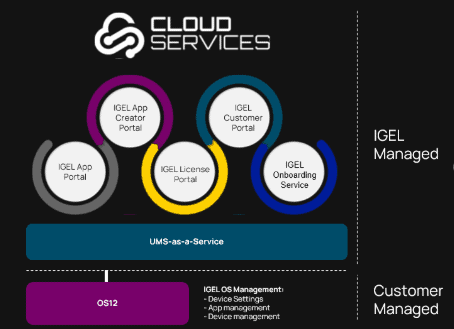
Strong Security & Compliance
Security is built into IGEL UMS as a Service (UMSaaS) from the ground up:
- Zero Trust Ready: Strong authentication and role-based access controls ensure only authorized users can manage endpoints.
- Read-Only OS Security: IGEL OS endpoints are inherently secure, preventing malware installations and unauthorized modifications.
- Integration with SIEM Solutions: UMSaaS allows logs to be exported to Security Information and Event Management (SIEM) platforms for compliance monitoring.
- Automatic updates: Continuous updates ensure that security patches and new features are always applied without manual intervention.
Faster Deployment & Reduced IT Burden
With IGEL UMSaaS, IT teams can deploy IGEL OS endpoints in minutes rather than days. There’s no need for manual provisioning, and updates are applied automatically.
- Pre-configured Quick Start Templates enable fast deployment of IGEL OS devices with minimal setup time.
- Distributed Peer Updates app enables the IT admin to set up one endpoint device as the peer update server so that only this device will access the main server to download the updates. All other devices access the distributed peer update server from within the network and will no longer offload the outside network.
Auto-scaling capabilities support organizations of any size without performance bottlenecks.
- More efficient use of IT resources – teams can focus on strategic initiatives rather than endpoint maintenance.
- Consistent user experience – standardized configurations ensure every user gets a seamless, secure experience.
- Lower IT support burden – fewer troubleshooting calls and faster resolution times.
Distributed, Hybrid, and Global Workforces
IGEL UMSaaS makes managing remote and hybrid workforces effortless by allowing IT administrators to deploy, monitor, and update devices anywhere in the world via a web browser —without requiring VPNs or on-premises infrastructure.
Modernize Your Enterprise Endpoint Strategy with IGEL UMSaaS
As enterprises continue to embrace cloud-first strategies, IGEL UMSaaS provides the scalability, security, and ease of use required to manage modern endpoints effectively. By eliminating infrastructure complexity and automating key management tasks, IT teams can focus on delivering exceptional user experiences while maintaining robust security.
Whether you’re looking to reduce costs, enhance security, or simplify endpoint management, IGEL UMSaaS is the cloud solution that helps future-proof your digital workspace.
Would you like to explore how IGEL OS can support your digital workspace strategy?
Contact us today to learn more about how IGEL UMSaaS can streamline your digital workspaces.
The post Cloud-Powered Endpoint Management for the Modern Enterprise appeared first on IGEL.
]]>The post IGEL Introduce a Managed Hypervisor to Secure Your Legacy Workloads appeared first on IGEL.
]]>But why are we doing this?
There are industries who rely on systems which run older hardware which you can no longer buy and operating systems which are no longer in support nor are they receiving security patches and updates. Imagine a factory from the 1980s—big machines on vast production lines. These machines (Operational Technology, or OT) did their thing, producing goods, with little connection to the outside world. Meanwhile, the back office PCs, laptops, or thin clients (Information Technology, or IT) handled emails, spreadsheets, and software, both technologies siloed in a separate universe.
Fast forward to today and industry 4.0 These two worlds — IT and OT are converging.
In industries such as manufacturing, healthcare, logistics, and government, Operational Technology (OT) networks remain a critical part of daily operations. However, many of these systems still rely on legacy Windows operating systems—such as Windows XP or Windows 7. This creates significant vulnerabilities, leaving essential cyber-physical systems (CPS) like medical devices, industrial controllers, and building management systems exposed to cyber threats.
Desktop Image of IGEL managed Hypervisor running two versions of Windows OS. Click to open the demo video.
IGEL is tackling these challenges head-on with its latest innovation: IGEL Managed Hypervisor. This solution runs on IGEL OS 12 and incorporates the IGEL Preventative Security Model , along with centralized management through the IGEL Universal Management Suite (UMS). By doing so, IGEL enables enterprises to protect legacy systems while eliminating the risks, costs, and operational disruptions associated with outdated endpoint hardware.
, along with centralized management through the IGEL Universal Management Suite (UMS). By doing so, IGEL enables enterprises to protect legacy systems while eliminating the risks, costs, and operational disruptions associated with outdated endpoint hardware.
The Risks of Legacy Windows in OT Networks
Organizations operating in OT environments face a unique set of cybersecurity and operational challenges:
- Security Vulnerabilities
- Aging Hardware Dependence
- Compatibility Issues
- Operational Downtime
- Regulatory Compliance Risks
- Lack of Centralized Management
The IGEL Managed Hypervisor Advantage
IGEL Managed Hypervisor is a secure endpoint virtualization platform that enables legacy Windows operating systems to run safely on modern hardware, mitigating security risks while ensuring operational continuity.
- Security & Compliance
- Operational Continuity
- Cost Savings & Sustainability
Future-Proofing Critical OT Networks
Organizations reliant on legacy operating systems for mission-critical operations can now ensure security, compliance, and business continuity without being burdened by aging hardware constraints. With IGEL Managed Hypervisor, enterprises can confidently protect their OT networks while embracing a future-ready security posture.
A Strategic Move for IGEL in OT Cybersecurity
Beyond its technical advantages, IGEL Managed Hypervisor positions IGEL as a leader in the growing convergence of IT and OT security. By providing a secure bridge between legacy systems and modern infrastructure, IGEL is expanding its role beyond traditional endpoint management to address the urgent cybersecurity needs of industrial, healthcare, and governmental sectors.
IGEL Managed Hypervisor is available in Q2 2025 in the IGEL App Portal.
Learn more on igel.com/secure-managed-hypervisor/
View the IGEL Managed Hypervisor Demo Video
Contact us today to discuss how we can help your organization stay protected.
The post IGEL Introduce a Managed Hypervisor to Secure Your Legacy Workloads appeared first on IGEL.
]]>The post A Defense in Depth Approach to Business Continuity appeared first on IGEL.
]]>Achieving operational resilience demands robust planning and risk management amidst constant siege from cyber threats and unforeseen disruptions. IT leaders planning business continuity and security must ask themselves one critical question: How fast can we recover? Cybersecurity breaches and IT outages are no longer rare occurrences—they are the storm clouds on every CIO’s horizon. In 2024 alone, incidents ranging from ransomware attacks, to software outages, natural disasters or so-called snow days cost enterprises billions and left operational teams scrambling to regain control.
Resilience is enabled by a robust business continuity plan (BCP). While most organizations back up data and upgrade infrastructure, one crucial component often goes overlooked—the endpoint. The frontline devices that users depend on daily are the most vulnerable, and when compromised, can disrupt operations at scale.
IGEL Business Continuity solution is not just about reactive disaster recovery but about proactive resilience. By combining an emergency “911” or “999” solution, organizations can get back up and running quickly and securely, amidst a breach or outage.
Defense in Depth (DiD) is a cybersecurity strategy that uses multiple layers of security controls to protect data and systems from threats. Instead of relying on a single defense mechanism, DiD ensures that if one layer is compromised, others are still in place to mitigate risks. IGEL Business Continuity offers an in–depth approach to endpoint recovery including IGEL Business Continuity Dual Boot, IGEL Business Continuity USB boot and services.
What sets IGEL apart is not just speed but strategy. Deployment is set up in advance with an IGEL Specialist, ensuring that authentication protocols, virtual desktop clients, and collaboration tools like Teams and Zoom are integrated and ready. IT regains control and can manage recovery in minutes and hours, not days or even weeks.
Moreover, as part of the IGEL Preventative Security Model, IGEL OS operates as a read-only system with no local data storage, aligning perfectly with zero-trust security principles. No endpoint data, no persistent risk.
In hybrid work scenarios, IGEL Business Continuity extends beyond office walls. Employees stranded at home by weather or transport issues can securely access corporate resources using personal devices, booting directly into IGEL OS without risking company data leaks.
Cyber threats and IT outages will continue to rise. But with IGEL Business Continuity in your BCP toolkit, they don’t have to disrupt your operations. Don’t wait for an emergency to test your business continuity plan. Strengthen it now with IGEL Business Continuity.
View the Demo Video
Learn more, visit igel.com/business-continuity
The post A Defense in Depth Approach to Business Continuity appeared first on IGEL.
]]>